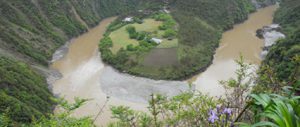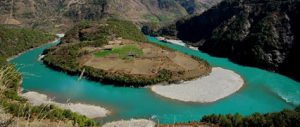China’s energy plans for the 12th Five-Year Plan, the country’s development blueprint to 2015, include restarting hydroelectric dam plans on the Nu River, a process that stalled almost a decade ago due to fears for the pristine ecosystem of this part of south-west China.
Though the construction programme was shelved back in 2004, advocates didn’t give up: the local government has been making annual lobbying trips to Beijing to muster support for Nu River dams from the central authorities, according to informed sources.
Over the last two years, the company that would actually build the plants – Yunnan Huadian Nu River Development Company, a subsidiary of Chinese energy giant Huadian Power – has held numerous meetings about pushing forward preliminary work.
Today, development of the Nu once again looks like a done deal. But relocation of local people set to lose their homes, environmental protection and potential geological risks remain major stumbling blocks. The row between developers and conservationists is set to continue.
Wen Jiabao shelves dam plans
Rising in the Dangla Mountains on the Tibetan plateau, the Nu River flows through Tibet into Yunnan and then onto Burma, where it is known as the Salween, before finally reaching the Indian Ocean. Within China it flows for more than 2,000 kilometres, passing through a steep gorge known as the Grand Canyon of the East. Stretches of the river fall within the Three Parallel Rivers area, a UNESCO World Heritage Site. The Nu is the only major river in China still free of large dams.
The peace of the Nu River was first shattered 10 years ago. In August 2003, the National Development and Reform Commission (NDRC), China’s top economic planner, met to approve Yunnan’s scheme for hydroelectric development on the middle and lower reaches of the river. Plans included construction of two reservoirs and 13 dams. Total electricity generation would be at least 21.32 gigawatts.
Read also: Averting a nightmare on the Nu
The plans immediately met fierce opposition. Representatives of the then State Environmental Protection Agency (now the Ministry of Environmental Protection) attending the meeting refused to sign off on the plan. Of China’s rivers, only the Nu and Yarlung Zangbo had not suffered significant ecological damage, they said, and as such should be retained as examples and models rather than being developed.
In September the same year, three key reasons for opposing the damming of the Nu River were presented at a meeting held by SEPA. They were: hydroelectric development and the construction of dam cascades would go against the principle of protecting the Three Parallel Rivers heritage site; caution should be used with anything that could threaten the outstanding natural beauty of the Nu River valley; and local species and culture required protection.
Campaign groups including Green SOS and Friends of Nature pointed out that the Three Parallel Rivers area accounts for less than 0.4% of China’s territory, but is home to 25% of its higher animal and plant species, including 77 state protected species, making it a globally significant repository of genetic resources.
In February 2004, citing social concern and disagreements over environmental protection, Chinese premier Wen Jiabao ordered a “cautious and scientific approach”. With that, hydroelectric development of the Nu River was shelved.
Geologists raise earthquake fears
Debate over the matter has continued – it even featured in a question in the 2008 examination for entry to China’s civil service.
In February 2011, four geologists wrote to the State Council leadership opposing the damming of the Nu River for geological reasons, again bringing the case to public attention. Signatories included Xu Daoyi of the China Earthquake Administration, Sun Wenpeng of the China National Nuclear Corporation’s Beijing Research Institute of Uranium Geology and Li Dongxu, professor at the China University of Geosciences.
Their language was blunt: “The Nu River is on an active fault with frequent earthquakes, and in a landslide-prone area subject to frequent downpours…Due to high seismic and geological risks, large dams should not be built here.”
This presented a new challenge. In the past, opposition had always been about the environment – this was the first mention of geological dangers. The subsequent earthquake in Japan meant the central government took the geologists concerns seriously. Yu Xiaogang of Yunnan NGO Green Watershed told Time Weekly that Wen Jiabao ordered in-depth research into the geological and seismic risks of the Nu River.
But a March 2011 seminar on the seismic risks of Nu River dams held by the China Society for Hydropower Engineering and the China Dam Commission came to a different conclusion.
Xu Xiwei, deputy head of the China Earthquake Administration’s Institute of Geology said: “Dams will collapse if they are built over a fault and an earthquake strikes. But in reality, if you make sure the dams don’t straddle a fault and are built in earthquake-resilience, hydroelectric development is safe.”
Joint research by the Hydropower and Water Resources Planning & Design General Institute and the China Earthquake Administration’s Institute of Earthquake Science found that, historically, earthquakes on the middle and lower reaches of the Nu have been rare and minor. Compared with the complex geology of much of south-west China, the Nu River basin is actually relatively stable, it concluded.
Local government pushes for development
Despite the controversy, the local government has for years been keen for hydroelectric development. The Nu River prefecture is the country’s only Lisu nationality autonomous prefecture. Local party secretary Duan Yueqing says more than 70% of the area’s 500,000 residents live in poverty, making it one of the poorest parts of China.
But in resources it is one of the richest. Its hydroelectric potential is world-class, accounting for 47% of the province’s total and making it one of the top six hydroelectric sites in China. The Nu is said to be China’s fifth largest river, with over 20 gigawatts of hydroelectric potential in its middle and lower reaches alone.
It is also home to huge mineral wealth. Almost 300 deposits of 28 different ores, including zinc, lead, copper, gold and tungsten, have been identified here. Within one 3.2-square kilometre area alone, there are thought to be 1,432 tonnes of lead and zinc, worth around 100 billion yuan, making it China’s biggest confirmed lead and zinc deposit to date.
In early 2007, Nu River Prefecture set upon an economic strategy centred on becoming a nationally important centre of metal extraction and hydroelectricity. The local government chiefs saw hydroelectricity as the quickest route to results.
Read also: At fault on the Nu River
In March 2008, the NDRC published its plans for development of renewable energy during the 11th Five-Year Plan, including hydroelectric plants at Liuku and Saige on the Nu River. There was opposition on environmental grounds, and the environmental authorities are still to approve the plans. But since 2003, preliminary work for dams on the Nu has continued.
In 2008, work quietly started on the Liuku dam, despite not having state approval. Residents in upstream villages were moved to “socialist new villages”. Today, the gate to the Liuku site is locked and work has halted, but the temporary dyke which will allow construction of the main dam is complete.
In late January 2011, Shi Lishan, deputy head of the New and Renewable Energy Office at the National Energy Administration (NEA), said that preliminary work, particularly research and design, for Nu River dams had continued. While there was no exact or complete programme in place, the Nu River would be developed, he said. This was the first time the NEA had taken a clear stance on the issue.
Last month, the State Council Office published plans for energy development during the 12th Five-Year Plan. These included full hydroelectric development drives on the middle and lower reaches of the Jinsha and Lancang, the Yalong, the Dadu, the upper reaches of the Yellow River and the middle reaches of the Yarlung Zangbo, along with an orderly start to development of the upper reaches of the Jinsha, Lancang and Nu.
An employee of Huadian’s Nu River subsidiary said as yet there is no timetable for work to start on the four dams it is planning – that will depend on state approval – but that “work is certain to start at Liuku first.”
Campaigners object
Hydroelectric development of the Nu River looks like a done deal, but Yunnan’s Energy Bureau remains circumspect. An official at the bureau told Times Weekly that “the provincial government regards this as very important, but is also very cautious,” going on to admit that “plans are just plans – carrying them out will still be very difficult, and there’s huge pressure over environmental concerns.”
Doubting voices are still heard. Environmental campaigner Yu Xiaogang said announcements about restarting the programme were made hastily: “It was done so things would be decided before the Lianghui [China’s annual parliamentary session in March]. Public opinion wasn’t sought, in contravention of rules on openness of information.”
Yu said that he and other Chinese green NGOs would carry out their own investigation in mid-February, to “gain a deeper understanding to the background to the decisions and what forces were at work behind the scenes, in order to then make further appeals and raise doubts.”
Noted water conservationist Weng Lida does not oppose the development of the Nu River per se, but urged prudence: “How to develop it reasonably, appropriately, scientifically, that’s something that needs huge caution. We still don’t have a solid foundation of environmental and risk assessments.”
This article was first published in Time Weekly



